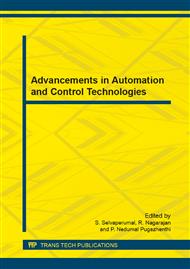[1]
Johan Akesson, Ola Sl¨atteke, Modeling, Calibration and Control of a Paper Machine Dryer Section, Modelica 2006, September 4–5.
Google Scholar
[2]
Paavo viitamaki, HYBRID MODELING OF PAPER MACHINE GRADE CHANGES, Espoo May (2004).
Google Scholar
[3]
Chang Hoe Heo, Hyunjun Cho, and Yeong-Koo Yeo, Dynamic modeling of paper drying processes, Korean J. Chem. Eng., pp- 1651-1657, (2011).
DOI: 10.1007/s11814-011-0046-0
Google Scholar
[4]
Johan Akesson, Ola Sl¨atteke, A modelica library for paper machine dryer Section modelling, August (2006).
Google Scholar
[5]
Yeong-Koo Yeo†, Ki-Seok Hwang, Sung Chul Yi and Hong Kang, Modeling of the Drying Process in Paper Plants, Korean J. Chem. Eng., pp-761-766, (2004).
DOI: 10.1007/bf02705517
Google Scholar
[6]
Anita Zvolinschi, Eivind Johannessen, Signe Kjelstrup, The second-lawoptimal operation of a paper drying machine, Chemical Engineering Science, pp-3653 – 3662, (2006).
DOI: 10.1016/j.ces.2005.12.030
Google Scholar
[7]
Danlei Chu, Michael Forbes, Johan Backström, Cristian Gheorghe and Stephen Chu, Model Predictive Control and Optimization for Papermaking processes, Advanced model predictive control.
DOI: 10.5772/18535
Google Scholar
[8]
Tutorial of paper making process, SCA Publication Papers Technical Support.
Google Scholar
[9]
Ola Slätteke, Modeling and Control of the paper machine drying section, Lund, January (2006).
Google Scholar
[10]
Teo Lian Seng, Marzuki Bin Khalid, and Rubiyah Yusof, Tuning of a Neuro-fuzzy controller by genetic algorithm, IEEE TRANSACTIONS ON SYSTEMS, MAN, AND CYBERNETICS—PART B: CYBERNETICS, VOL. 29, NO. 2, April, (1999).
DOI: 10.1109/3477.752795
Google Scholar
[11]
H. Sayoud, K. Takahashi, Senior Member, IEEE, and B. Vaillant, A Genetic Local Tuning Algorithm for a class of combinatorial Networks Design Problems, IEEE COMMUNICATIONS LETTERS, Vol. 5, No. 7, JULY (2001).
DOI: 10.1109/4234.935756
Google Scholar
[12]
Jinn-Tsong Tsai, Jyh-Horng Chou, Senior Member, IEEE, and Tung-Kuan Liu, Tuning the Structure and Parameters of a Neural Network by Using Hybrid Taguchi-Genetic Algorithm, IEEE TRANSACTIONS ON NEURAL NETWORKS, Vol. 17, No. 1, January (2006).
DOI: 10.1109/tie.2006.874280
Google Scholar
[13]
Michael J. Neath, Student Member, Akshya K. Swain, Member, Udaya K. Madawala, Senior Member, and Duleepa J. Thrimawithana, Member, An optimal PID controller for a bidirectional inductive power transfer system using multiobjective genetic algorithm, IEEE TRANSACTIONS ON POWER ELECTRONICS, VOL. 29, No. 3, March (2014).
DOI: 10.1109/tpel.2013.2262953
Google Scholar


